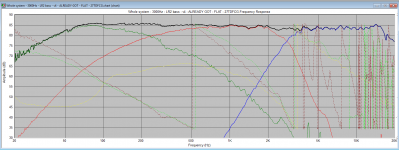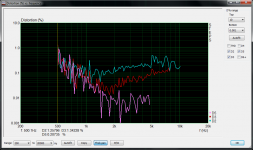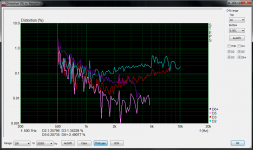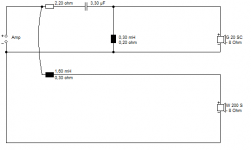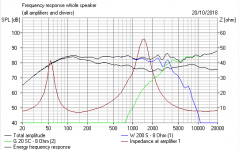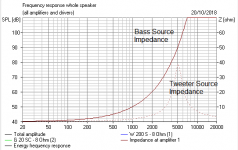Another thing is the so called "super" caps. These can be very expensive and every time I heard it, I had the feeling that they add some unwanted things to the signal, but that may be just me.
Being an analogue signal, any component in the signal path will degrade the original sound. Better components 'get in the way' less than cheaper components. What you are hearing is the intrinsic flaws in your design being heard more easily with the better components.
Once you have your xo sorted, better components will allow more of the original sound to come through. Though with any component there is a law of diminishing returns regarding sound quality v cost.
I can attest to 3KHz 4th order electrical (unsure of acoustic) really bringing out the best of the Seas 27TDFC/G (in my case) compared to 2KHz 2nd order electrical.
The strident treble has gone. I now need to listen if detail is sacrificed, but initial listening is very positive with much reduced listening fatigue.
I've come to the conclusion the Seas tweeters sound best at 3KHz with steep slopes... this might be for all 1" domes.
I listen to more demanding tracks. If you are a single instrument with a singer listener, you might be fine crossing the tweeter over wherever you like.
system7 (Steve) is on the money here.
The strident treble has gone. I now need to listen if detail is sacrificed, but initial listening is very positive with much reduced listening fatigue.
I've come to the conclusion the Seas tweeters sound best at 3KHz with steep slopes... this might be for all 1" domes.
I listen to more demanding tracks. If you are a single instrument with a singer listener, you might be fine crossing the tweeter over wherever you like.
system7 (Steve) is on the money here.
Here's what I am listening to. Much better than the 2KHz tweeter shallower LR4 slope version. This is a steeper version. Tweeter and midrange more balanced, even though they are playing "flat". My last crossover was 2KHz and was dipped by ~ 4 dB to try and get the tweeter to play nice.
Make no mistake - you are messing things up with this tweeter at a 2KHz LR4 or less crossover.
Make no mistake - you are messing things up with this tweeter at a 2KHz LR4 or less crossover.
Attachments
Thanks the suggestions guys!
I moved the xo point to around 2.8kHz LR4 with 3rd order electrical on the tweeter. Now this is not just slightly better, but much-much better than before and this is with cheap Jantzen Cross-Caps (now i think i don't need "better" caps) in the signal path.
Interestingly, people are sometimes very attached to their ideas. I originally chosed the 2kHz xo point to try avoid the elevated 3rd harmonic distortion from the midrange driver around this region and as a plus, the tweeter needs only a second order network combined with its natural roll-off to produce a matching LR4 slope. That was.
Another thing is the so called "super" caps. These can be very expensive and every time I heard it, I had the feeling that they add some unwanted things to the signal, but that may be just me.
Otherwise can you suggest some good tweeters which works with low xo point? Or this is generally not a good idea with the usual 1 inch domes?
Thanks!
You have experiences it yourself what I have been preaching for years. Using 25mm domes crossed at 2khz is the biggest mistake in audio of the last 20 years, just don’t go there at any cost.
I noticed another thing that might cause bad sound for dome tweeters at a low cut point.
Just look at these two graphs for the 27TFFC. The first contains a normal distortion measurement for the usual 2nd, 3rd and 5th harmonics. The second graph contains the 6+ order harmonics too. What a difference. From about 1khz and down the 6+ order harmonics begins to dominate the picture. If you ask me, this is really bad.
You know from puplished studies that higher order harmonics are more noticable and more unpleasant to the ear. So in this case the highest order is the loudest below 1kHz which is significantly in the audible range with low crossover points.
What causes this distortion? I think, the drivers mechanical limitations, like suspension stiffness, ferrofluid in the magnetic gap etc..
I saw some measurements where the tweeters Qms is the dominant (lower value) versus the Qes (higher value) of course around Fs like with other T/S measurements. Can you imagine such a woofer, how bad it can be?
Just look at these two graphs for the 27TFFC. The first contains a normal distortion measurement for the usual 2nd, 3rd and 5th harmonics. The second graph contains the 6+ order harmonics too. What a difference. From about 1khz and down the 6+ order harmonics begins to dominate the picture. If you ask me, this is really bad.
You know from puplished studies that higher order harmonics are more noticable and more unpleasant to the ear. So in this case the highest order is the loudest below 1kHz which is significantly in the audible range with low crossover points.
What causes this distortion? I think, the drivers mechanical limitations, like suspension stiffness, ferrofluid in the magnetic gap etc..
I saw some measurements where the tweeters Qms is the dominant (lower value) versus the Qes (higher value) of course around Fs like with other T/S measurements. Can you imagine such a woofer, how bad it can be?
Attachments
Last edited:
Once you have your xo sorted, better components will allow more of the original sound to come through.
Or starts to reveal other flaws in the reproduction chain.
HaHa, how they scoffed when I said the Zaph ZRT was a lousy design!
http://www.zaphaudio.com/ZRT.html
What could be wrong with a perfect LR4 at 1.7kHz?
Remember this one from earlier?
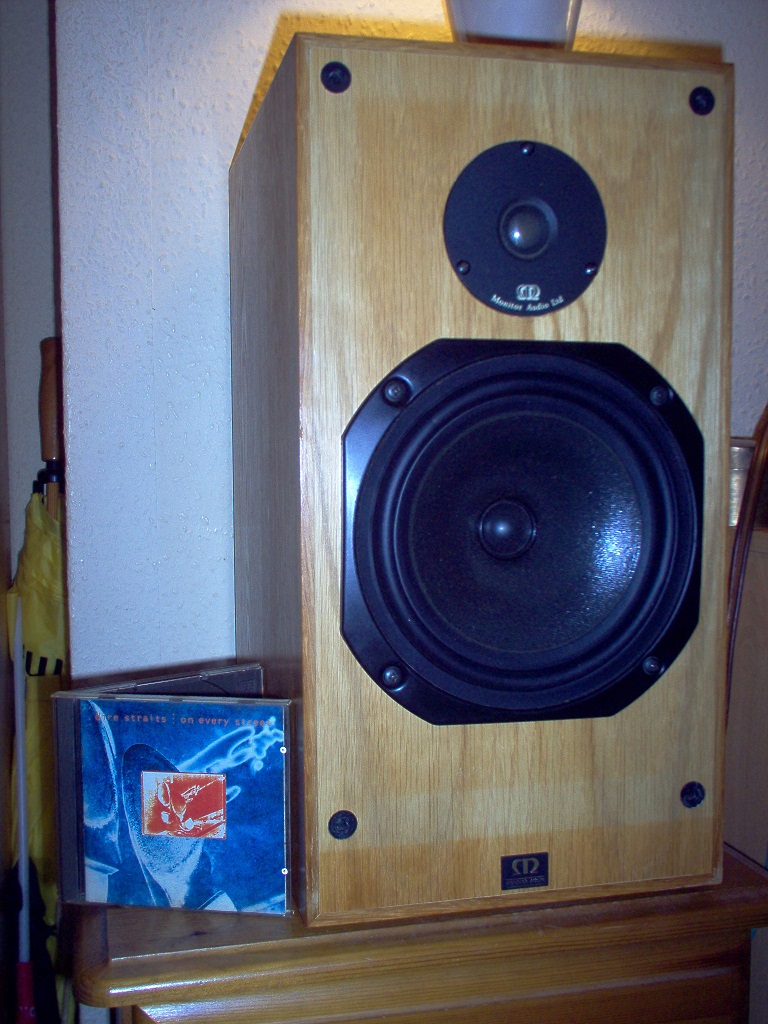
This is how I like to do this these days.

Below is the original Monitor Audio R300/MD filter, as when I bought them.
I didn't think much of them. Very harsh sound, IMO.
I do a lot better these days. But apart from flat impedance seen by the amplifier, another thing I look at is the source impedance seen by the drivers themselves. It's not very good in the original. The crossover definitely gets in the way.
http://www.zaphaudio.com/ZRT.html
What could be wrong with a perfect LR4 at 1.7kHz?
Remember this one from earlier?
This is how I like to do this these days.
Below is the original Monitor Audio R300/MD filter, as when I bought them.
I didn't think much of them. Very harsh sound, IMO.
I do a lot better these days. But apart from flat impedance seen by the amplifier, another thing I look at is the source impedance seen by the drivers themselves. It's not very good in the original. The crossover definitely gets in the way.
Attachments
I have probably missed something Steve, but if fallible memory serves I don't recall anybody claiming LR4 to be perfect. Which is probably a good job, since nobody with an ounce of common sense would claim anything to be perfect, be it LR4, a new carpet or a given recipe for a dry martini. 
Be that as it may, and speaking under correction, the ZRT you were particularly complaining about some time ago was actually the 2 1/2 way version, which is not 1.7KHz LR4, but ~3rd order Butterworth at 1.6KHz, which being -3dB rather than -6dB at Fc does put greater demands on the tweeter, as does the 2nd order electrical high pass. Conversely, the 2-way ZRT, with a slightly higher XO frequency, LR4 acoustical slopes (maximal power handling) at 1.7KHz and 3rd order electrical high pass is both a rather different animal in design terms, and, slightly ironically, should be less demanding on the HF unit.
Be that as it may, and speaking under correction, the ZRT you were particularly complaining about some time ago was actually the 2 1/2 way version, which is not 1.7KHz LR4, but ~3rd order Butterworth at 1.6KHz, which being -3dB rather than -6dB at Fc does put greater demands on the tweeter, as does the 2nd order electrical high pass. Conversely, the 2-way ZRT, with a slightly higher XO frequency, LR4 acoustical slopes (maximal power handling) at 1.7KHz and 3rd order electrical high pass is both a rather different animal in design terms, and, slightly ironically, should be less demanding on the HF unit.
Last edited:
- Status
- This old topic is closed. If you want to reopen this topic, contact a moderator using the "Report Post" button.
- Home
- Loudspeakers
- Multi-Way
- Tweeter upgrade?
